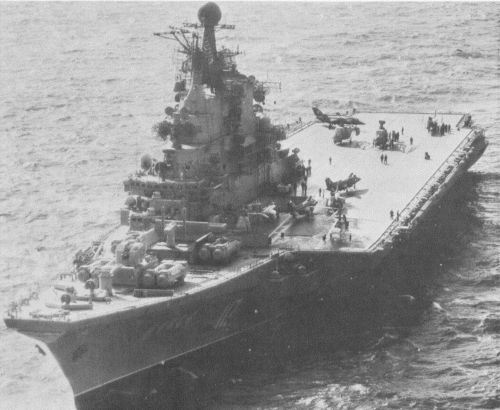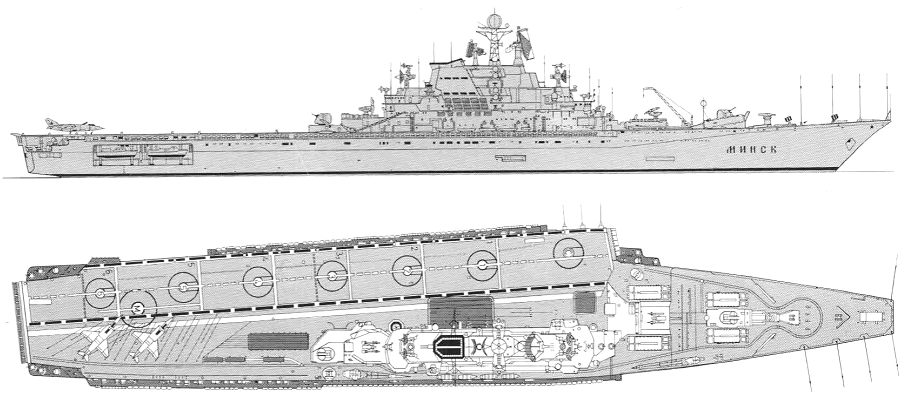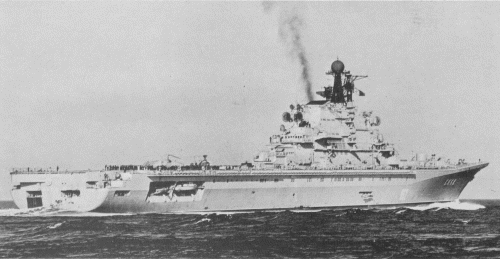
NAVYPEDIA
 Support the project with paypal
Support the project with paypal
Photo

Minsk 1979
Ships
| Name | No | Yard No | Builder | Laid down | Launched | Comm | Fate | Modification |
|---|---|---|---|---|---|---|---|---|
| Киев [Kiev] | 101 | Black Sea Yd, Nikolayev | 21.7.1970 | 26.12.1972 | 28.12.1975 | stricken 6.1993 | Project 1143 | |
| Минск [Minsk] | 102 | Black Sea Yd, Nikolayev | 28.12.1972 | 30.9.1975 | 27.9.1978 | stricken 6.1993 | Project 1143 | |
| Новороссийск [Novorossiysk] | 103 | Black Sea Yd, Nikolayev | 30.9.1975 | 26.12.1978 | 14.8.1982 | stricken 6.1993 | Project 11433 |
Technical data
| Displacement standard, t | 101: 30530 102: 30525 103: 31900 |
|---|---|
| Displacement full, t | 101: 41370 102: 41380 103: 43220 |
| Length, m | 273.1 |
| Breadth, m | pr. 1143: 31.0 wl 49.2 fd pr. 11433: 31.0 wl 51.3 fd |
| Draught, m | pr. 1143: 8.95 pr. 11433: 9.30 |
| No of shafts | 4 |
| Machinery | 4 sets TV-12-3 geared steam turbines, 8 KVN-98/64 boilers |
| Power, h. p. | 180000 |
| Max speed, kts | 32.5 |
| Fuel, t | oil |
| Endurance, nm(kts) | pr. 1143: 8000(18) pr. 11433: 7160(18) |
| Armament | pr. 1143 No 101: 4 x 2 Bazalt SSM (16 P-500(4K80)), 2 x 2 Shtorm SAM (96 V-611(4K60)), 2 x 2 Osa-M SAM (40 9M33), 1 x 2 RPK-1 Vyuga ASuM (16 82R), 2 x 2 - 76/59 AK-726, 8 x 6 - 30/54 AK-630, 2 x 5 - 533 TT (10), 2 x 12 RBU-6000 Smerch-2 ASWRL, 22 aircraft (Yak-38M attackers, Ka-25PS helicopters) pr. 1143 No 102: 4 x 2 Bazalt SSM (16 P-500(4K80)), 2 x 2 Shtorm SAM (96 V-611(4K60)), 2 x 2 Osa-M SAM (40 9M33), 1 x 2 RPK-1 Vyuga ASuM (16 82R), 2 x 2 - 76/59 AK-726, 8 x 6 - 30/54 AK-630M, 2 x 5 - 533 TT (10), 2 x 12 RBU-6000 Smerch-2 ASWRL, 36 aircraft (Yak-38M attackers, Ka-25, Ka-25PS helicopters) pr. 11433: 4 x 2 Bazalt SSM (8 P-500(4K80)), 2 x 2 Shtorm SAM (96 V-611(4K60)), 1 x 2 RPK-1 Vyuga ASuM (16 82R), 2 x 2 - 76/59 AK-726, 8 x 6 - 30/54 AK-630M, 2 x 12 RBU-6000 Smerch-2 ASWRL, 36 aircraft (Yak-38M attackers, Ka-27, Ka-27PS helicopters) |
| Electronic equipment | pr. 1143: MR-700 Fregat-M, MR-600 Voskhod, Volga, MR-212 Vaygach-1143, Argon-1143, 2x Grom-M, 2x 4R-33, MR-105 Turel', 4x MR-123 Vympel-A radars, Gurzuf, Gurzuf-1, MR-262 Ograda, Koltso ECM suites, MGK-335 Platina, MG-342 Orion, MGS-407K sonars, MI-110R, MI-110K wake detectors, 2x PK-2 decoy RLs, Alleya-2 CCS pr. 11433: MR-700 Fregat-M, MR-600 Voskhod, 2x MR-350 Podkat, Volga, MR-212 Vaygach-1143, Argon-1143, 2x Grom-M, MR-105 Turel', 4x MR-123 Vympel-A radars, Kantata-M, MR-262 Ograda, Koltso ECM suites, MGK-335 Platina, MG-355 Polinom, MGS-407K sonars, MI-110R, MI-110K wake detectors, 2x PK-2 decoy RLs, Alleya-2K CCS |
| Complement | 101: 1863 102: 1865 103: 2037 |
Air group
| Year | Attackers | Helicopters |
|---|---|---|
| 1975, Kiev | 13 Yak-38M | 2 Ka-25PS, 3 Ka-25Ts |
| 1978, Minsk | 14 Yak-38M | 16 Ka-25, 2 Ka-25Ts, 2 Ka-25PS |
| 1982, Novorossiysk | 16 Yak-38M | 18 Ka-27, 2 Ka-27PS |
Standard scale images

Minsk 1990
Graphics
Aircraft facilities
pr. 1143 (fd - 11,000 m², ha - 2,925 m² / 19,305 m³): Flight deck: 273.1 x 49.2m. Hangar: 130.0 x 22.5 x 6.60 m. There were 2 centreline elevators. Aircraft fuel stowage: 1200 t of jet fuel.
pr. 11433(fd - 11,000 m², ha - 2,925 m² / 19,305 m³): Flight deck: 273.1x 51.3m. Hangar: 130.0 x 22.5 x 6.60 m. There are 2 centreline elevators. Aircraft fuel stowage: 1800 t of jet fuel.
Project history
The TTZ for this class was approved on 16 October 1968. They were designed by TsKB-17. Chronology suggests strongly that the Kievs were associated with the Project 667B strategic submarines, which for the first time could fire from 'holding areas' which the Soviets could hope to control, such as the Norwegian Sea north of the GIUK Gap. It can be argued that the massive batteries of these ships were ideally suited to denying passage to NATO ASW forces, be they aircraft (which could be opposed by the Yak-38 fighter), surface ships (against which Kiev could release Bazalt cruise missiles), and submarines (against which she had a variety of weapons including her helicopters). As in the case of Moskva, this was hardly a traditional Western-type carrier function. Note, however, that the Yak-38 was observed primarily carrying ground-attack weapons, and appeared not to have any air intercept radar. If it was indeed intended to oppose NATO maritime patrol aircraft, especially the P-3, presumably it depended heavily on control by the ship; this would be in accord with standard Soviet fighter-control doctrine. In this context it was suggestive that the Yak-38 had an even design number, since the Soviets reportedly assigned odd numbers to fighters (eg MiG-21, -23, -25) and even ones to attack aircraft (eg Su-22).
Certainly among the most spectacular Soviet ships, these large cruisers or semi-cruisers combined the Moskva weapon system with the first reloadable SSM system since Project 58, and with the Osa-M point defence missile system. More importantly, to many analysts, they operated Yak-38 VTOL fighters. It was difficult to divine the relative priorities of these systems: certainly the deep magazine for Bazalt missiles took up a lot of space and even length. Unlike other Soviet ASW ships of their period, they did not have the Metel' torpedo-carrying stand-off missile, although they did have the Vyuga nuclear ASW system, and the helicopters could drop torpedoes, and some writers suggested that the Kievs were intended to support Soviet amphibious operations. That seems unhkely; it is more probable that they were intended to support Soviet ballistic missile submarines by helping to bar NATO access to SSBN 'holding areas' in wartime. In such a role their large hulls improve sea-keeping, and their three-dimensional armament would have allowed them to oppose penetration of their patrol areas by NATO ASW aircraft, surface ships or submarines. However, it should be noted that the second ship to be completed, Minsk, went to the Pacific Fleet in mid-1979 instead of supplementing the Kiev in Northern Fleet. Moreover, only four ships were built, which hardly seemed sufficient to block the GIUK Gap.
A recent Soviet account suggests that Kiev was conceived as a lengthened Moskva, with additional helicopters. This enlargement could not overcome the basic defects of the design, and it had to be extensively rethought. The original ship had four helicopter take-off spots, and the new one was intended to have six. However, a seventh was needed for an alert search and rescue helicopter. There was no space for sufficient spots abaft the island, so they were lined up to form the characteristic angled through deck of the Kiev class. The larger ship could accommodate the additional armament which had been desired for the Moskva class. The powerplant was simply two Moskva plants. According to this account, the ship was not conceived as a carrier. Her anti-ship missiles were added in the draft design stage, the concept design stage during which detailed trade-offs are worked out. The fixed-wing air group was only decided upon about 1968, the Yak-36 VTOL prototype having interested naval personnel after its 1967 debut. A Yak-38 flew from Moskva for the first time on 18 November 1972.
The Novorossiysk design (Project 11433) was modified to provide for 50% more aircraft, as well as a new sonar and new electronic warfare equipment. She lacked Osa-M SAM, and instead was fitted to take the successor Kinzhal SAM (six VLS abaft the island and six forward to port), but due to lacking of that SAM in time of completion of the ship Novorossiysk came to service and served without point defence SAM. Also she would carry Yak-41 supersonic VTOL fighters, but she never received them.
The fourth ship, Baku (later renamed Admiral Flota Sovetskogo Soyuza Gorshkov, Project 11434) was again modified. She had a new phased-array radar, a new fighter control system and more anti-ship missile launchers (twelve, to provide a larger salvo; but there were no reloads). She had Kinzhal vertically-launched point defence missiles in place of the earlier Osa, but she lacked the medium-range SAM of the earlier ships. The 76mm dual-purpose guns were replaced by 100mm weapons. The earlier RBU-6000 system was replaced by a pair of new RBU-12000 anti-torpedo systems. The forward gun sponson before the angled deck was eliminated, and the superstructure frame made 'more dignified'. In effect the fourth ship introduced the electronic suite later used in the full carrier Kuznetsov. The mass of new systems took quite some time to install, and the ship's construction was quite protracted.
By late 1991 all surviving Yak-38 Forgers were out of service, considered either too worn out or too dangerous for use. The projected successor, the supersonic Yak-41, had fallen victim to the Soviet economic collapse and seemed unlikely ever to enter production (the Yak design bureau had failed to find any foreign sponsors). One of the two flying prototypes had crashed.
Ship protection
Underwater protection consists of 3 longitudinal bulkheads (2nd bulkhead is armoured).
Modernizations
1980s, Kiev: was modernized to carry Ka-27 helicopters.
Naval service
No significant events.
 HOME
HOME FIGHTING SHIPS OF THE WORLD
FIGHTING SHIPS OF THE WORLD RUSSIA / USSR
RUSSIA / USSR AIRCRAFT CARRYING SHIPS
AIRCRAFT CARRYING SHIPS KIEV class heavy aircraft carrying cruisers (project 1143) (1975 - 1982)
KIEV class heavy aircraft carrying cruisers (project 1143) (1975 - 1982)

